Pet Insurance Review > Pet Wellness Guides > 7 Tips for Dog Water Safety - Pet Insurance Review
7 Tips for Dog Water Safety
Posted: 07/16/2022 | BY: Erin Cain | Categories: Dog , Pet care
Summertime is a great time to get out and enjoy the water, whether at the beach, a pool, or even just playing in the sprinkler. It can be a lot of fun for both dogs and owners alike. However, water safety is essential for dogs, too, especially during the hot summer months. This article will discuss 7 tips for dog water safety to keep your pup safe while enjoying water activities this summer.
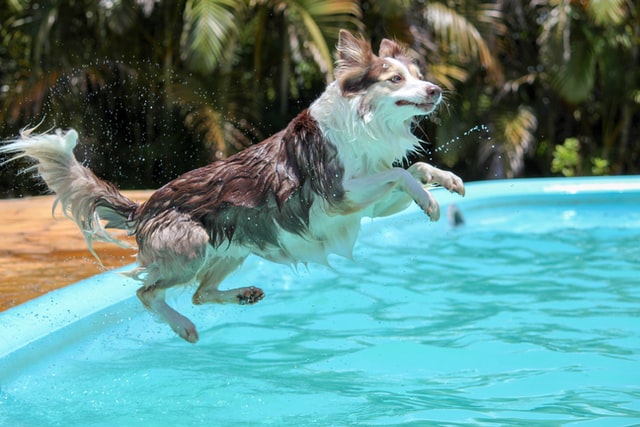
Dog water safety tips for dogs
There’s nothing like spending time in the water with your dog to make him happy, especially during summer. Dog swimming is a great exercise that can keep your furkid happy and healthy. However, you must know some basic rules about dog water safety so your pup can have fun without risking his life.
An estimated 5,000 dogs drown yearly in water accidents, often because dog owners left their dog unattended or the pup did not know how to swim.
Here are Pet Insurance Review’s top dog water safety tips to ensure a fun, wet, yet safe summer for your pooch.
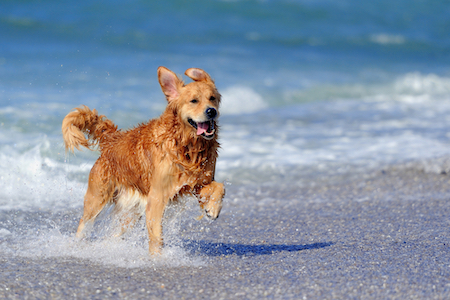
1. Never leave your dog unattended near water.
Take care when it comes to your dog’s safety around water. Just as you would with children, keep an eye on your furkid, no matter what body of water your dog is swimming in. To keep your pup safe, use a fence or cover preventing them from getting into the water, especially when the dog owners aren’t home. Accidents can happen in seconds; that second is often all it takes for an unattended dog to suffer an injury or drown in the water.
Always supervise dogs while playing around shallow waters or in a swim session, but also keep an eye on them afterward. Watch for signs that could be infection related, like bloody diarrhea, lethargy, vomiting, fever, or lack of appetite. Your furry friend may have developed an illness due to bacterial exposure. The sooner this issue gets treated by a vet will ensure your furkid’s best possible chance at recovery.
2. Prepare your dog for the water.
Many people think that all dogs are natural swimmers, but this is not true. Not all dogs know how to swim! Some breeds are natural born swimmers. However, many dog breeds are not because they lack the physical capacity to stay afloat in water or find support from their legs when trying to doggy paddle. Breeds like the Golden Retriever and Labrador Retriever have the inborn talent to swim; however, that doesn’t mean that every dog of those breeds likes to swim. If your dog is averse to water, never force him to swim.
A canine needs a body shape conducive to dog swimming to stay afloat. Breeds with short legs and large, broad chests, like the Bulldog, will find it challenging to manage in the water. Small breed pups, such as the Chihuahua or Maltese, may be easily and quickly overwhelmed by waves or currents. Flat face or brachycephalic breeds are highly susceptible to breathing problems. These breathing issues make these dogs wear out fast from swimming, making them vulnerable to water hazards. Dog water safety means knowing what your dog needs to play safely in the pool or pond.
Suppose your pup wants to go in the water but doesn’t know how to swim. Make sure to train your furkid to swim before taking him out into any bodies of water. Even if your dog becomes a swimming guru, remember to take multiple short breaks during swims. Swimming is more tiring than running, so watch for signs of fatigue, including trembling and heavy panting. Taking short breaks prevents your furry buddy from potential health problems and hazards.
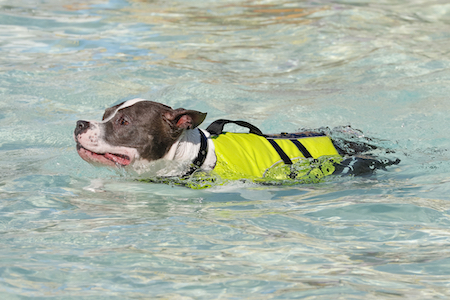
3. Invest in a dog life jacket.
Whether your furry friend is an experienced or rookie swimmer, he should always wear a life jacket when in the water. A properly-sized life vest is not only a potential lifesaver, but it allows the dog to feel more confident while swimming.
You want your dog’s first experience in the water to be fun, not frightening. Never throw a puppy or dog into a pool of water as that is dangerous and may also turn your dog off from swimming for life. A dog’s life vest will help him float while he gets his bearings and realizes that he can move around in the water by paddling. However, without this safety device, a canine may panic, flail, swallow too much water, and drown within minutes. Even the most confident swimmers can end up in trouble, so a life jacket is a must for any water dog.
Keep your furkid safe while they enjoy the water by choosing a durable jacket made of waterproof materials. It should also be adjustable, so it fits appropriately to the dog’s body type. Look for life jackets with reflective trim for increased visibility in low light conditions and a handle to grab and lift the dog out of the water if necessary. Consider jackets with an extra flotation piece under the pup’s chin to help keep him afloat.
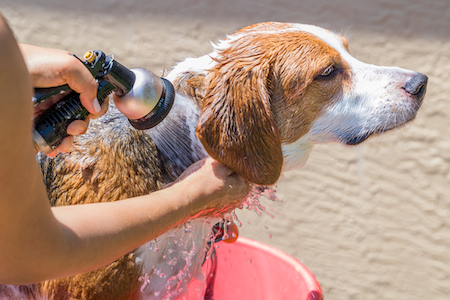
4. Rinse your dog after swimming.
Rinse your dog (or preferably bathe) each time in the water. If your pup swims in a home pool, the salt, chlorine, and other pool chemicals could irritate the skin and make him sick if he licks his fur and ingests any of it. Bathing helps remove those chemicals and alleviate any itching or discomfort.
If your dog swims in open water — ponds, lakes, streams, rivers, or ocean water — it’s necessary to bathe him thoroughly. Unfortunately, many chemicals in water supplies and even more bacteria can cause canine illnesses such as leptospirosis and giardia. Not only do you want your dog clean from bacteria, but you don’t want him trailing it all over your home.

5. Don’t let your dog drink the water.
Do everything possible to prevent your dog from drinking his swimming water. Bodies of water carry bacteria, algae, or parasites that could give your pup diseases. As for ocean water, the salt levels can dehydrate a dog who drinks too much of it, resulting in “beach diarrhea.” When a dog ingests large quantities of salt water, salt poisoning or hypernatremia causes severe neurological impacts on the animal.
Beware of algae blooms, including red tide and blue-green algae. Red tides are caused by plantlike organisms and are found in salty coastal waters. They produce toxic chemicals affect marine life, end up on land, and are even released into the air. Red tides cause neurological and respiratory problems. Blue-green algae are in freshwater, and the bacteria appear as if covered in slime and of a dull green color. A dog in contact with this algae may suffer liver damage, neurological issues, and death.
Bring plenty of fresh drinking water for your dog, so he never resorts to drinking from pools, ponds, lakes, and rivers.
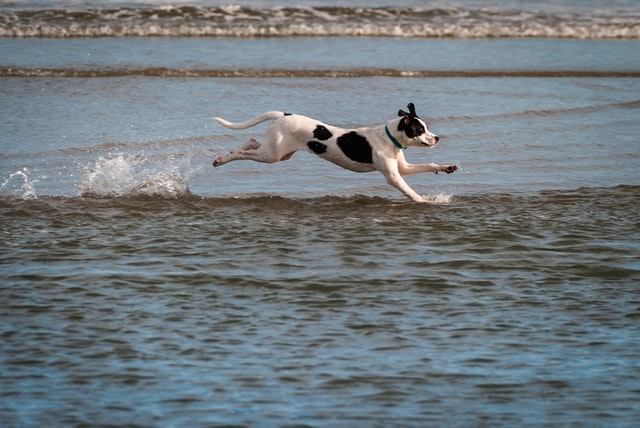
6. Steer clear of fishing locations.
Avoid swimming your dog in fishing areas. It’s difficult to see the fishing line but easy for your dog to get tangled up. Fishing hooks can puncture your dog’s skin or get stuck in his paws. Perhaps even worse, many dogs wind up at the vet with embedded hooks in their nose or tongue. It’s also not rare for a dog to swallow a fishing hook. Your best bet to keep your pup safe in the water is to stay away from fishing piers or popular fishing locations.
7. Avoid water-related hazards.
There are a host of water-related hazards dogs can encounter while swimming. Here are the top three to know:
- Hyponatremia, or water intoxication, is a rare yet potentially fatal condition. It occurs when dogs ingest large quantities of water very quickly. This health problem may happen to dogs who frequently dive open-mouthed into a pool or pond for their ball. Too much water too fast leads to a drop in electrolytes in the blood, followed by a thinning of blood plasma. The result is swelling of the brain and other organs, leading to death.
- Acute caudal myopathy, also known as “swimmer’s tail” or limber-tail syndrome, is when a dog’s tail droops due to too much time in the water. The dog uses his tail to swim, and overexertion of that tail can strain the muscles responsible for holding it up. The base of the tail may become stiff, causing the dog significant pain.
- Hypothermia, or abnormally low body temperature, impacts dogs who swim in cold water temperatures for an extended period. Aside from the water, wind chill, cloud cover, and damp air can contribute to the formation of hypothermia. Always follow this rule: if the water is too cold for you, it’s too cold for your pup.
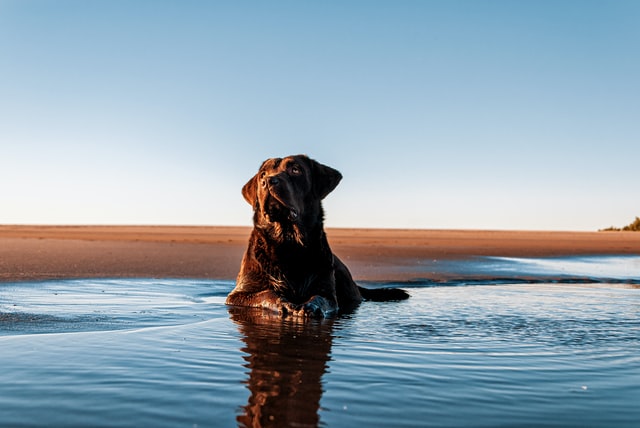
Swim to safety with a dog pet insurance plan.
Lots of dogs love to swim, and many are good at it, but that doesn’t mean that accidents can’t happen. If your dog has dog water safety issues when swimming, you’ll want to know that your pup has health care that can cover an emergency. Learn more about how Pet Insurance Review can help you find the right canine health coverage by starting with a free quote!
References:
- Morgan, J. (2021). Swimming Dogs. Retrieved from https://drjudymorgan.com/blogs/blog/swimming-dogs
- Orvis Staff. (2020). The Best Dog Breeds for Swimming. Retrieved from https://news.orvis.com/dogs/the-best-dog-breeds-for-swimming
- Gibeault, S. (2021). Can All Dogs Swim? How to Teach a Dog to Swim. Retrieved from https://www.akc.org/expert-advice/health/teach-dog-to-swim/
- Cain, E. (2022). Leptospirosis in Dogs: What Pup Parents Need to Know. Retrieved from https://www.petinsurancereview.com/blog/leptospirosis-dogs-what-pup-parents-need-know
- Brewer, M. (2020). Giardiasis in Dogs. Retrieved from https://todaysveterinarypractice.com/parasitology/giardiasis-in-dogs/
- Farricelli, A. (2022). The Effects of Salt Water on Dogs. Retrieved from https://pethelpful.com/dogs/The-Effects-of-Salt-Water-on-Dogs
- EPA. (2022). Harmful Algal Blooms. Retrieved from https://www.epa.gov/nutrientpollution/harmful-algal-blooms
- Centennial Animal Hospital. (2018). Water Intoxication in Dogs. Retrieved from https://www.centennialanimalhospital.com/water-intoxication/
- Riley, E. (2020). Swimmer’s Tail in Dogs. Retrieved from https://veterinarypartner.vin.com/default.aspx?pid=19239&catId=102899&id=9802889
- Eldredge, D. (2020). Recognizing the Dangerous Signs of Hypothermia in Dogs. Retrieved from https://www.dailypaws.com/dogs-puppies/health-care/dog-conditions/hypothermia-in-dogs
The information contained on this blog is intended for informational and educational purposes only and should not be construed as medical advice. It is not a substitute for professional veterinary care. Always consult with your veterinarian before making any changes to your pet's health care or treatment plan.
The authors of this blog are not veterinarians and do not claim to be experts in pet health. The information provided here is based on our own experiences and research, as well as information from reputable sources. However, we cannot guarantee the accuracy or completeness of this information.
We encourage you to do your own research and consult with your veterinarian before making any decisions about your pet's health.